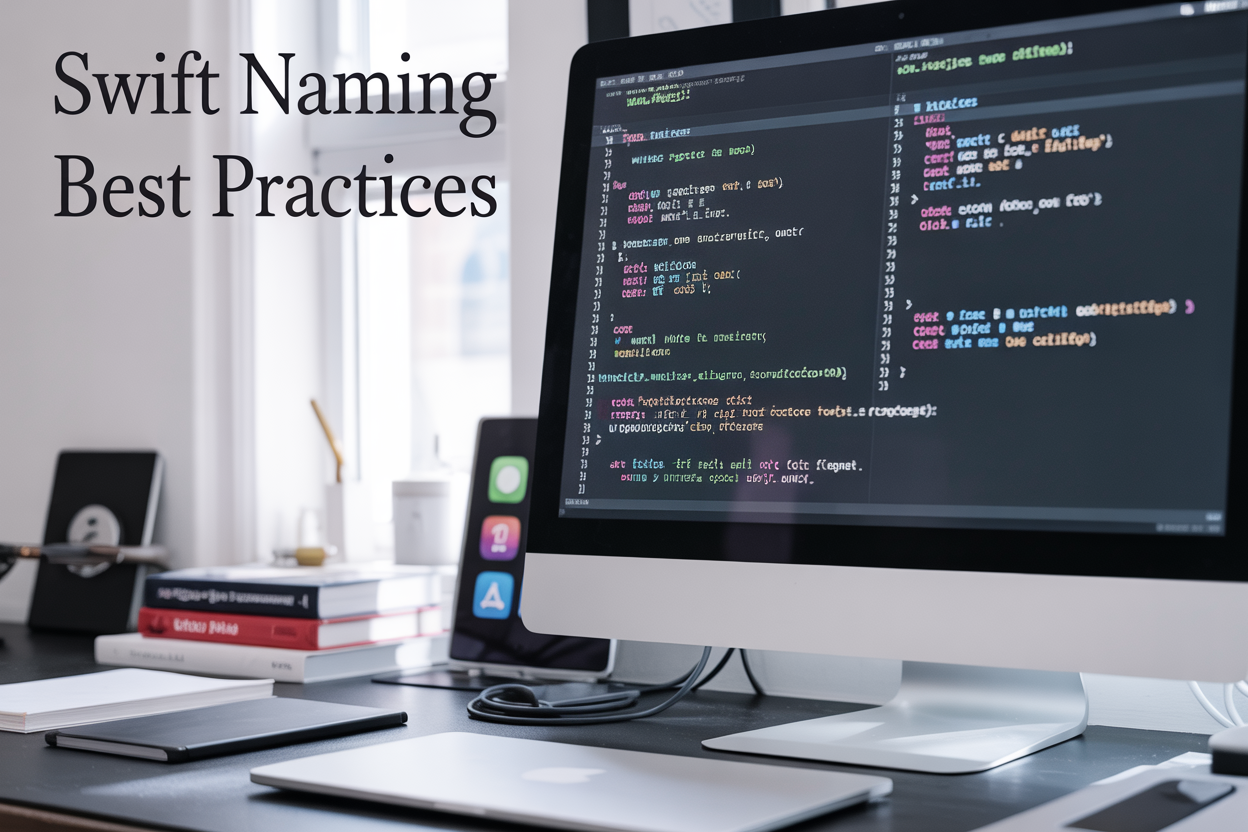Clean, consistent code separates professional iOS developers from beginners. Swift coding standards and proper naming conventions make your apps maintainable, readable, and ready for team collaboration or App Store success.
This guide targets iOS developers who want to write production-quality Swift code that follows industry standards. Whether you’re preparing for senior developer roles, joining a development team, or building apps for clients, mastering these Swift best practices will elevate your programming skills.
We’ll cover the essential Swift naming conventions that every professional developer needs to know. You’ll learn proven techniques for Swift variable naming and Swift function naming that make your code self-documenting. We’ll also explore advanced iOS code organization strategies and mobile app development standards used by top tech companies to keep large codebases manageable and bug-free.
Foundation of Swift Naming Conventions

Understanding Apple’s Swift API Design Guidelines
Apple’s Swift API Design Guidelines form the backbone of professional iOS development, providing a clear framework for creating clean, intuitive code. These guidelines emphasize clarity at the point of use, where code should read like natural English sentences. The core principle revolves around making APIs self-documenting through thoughtful naming choices.
The guidelines establish three fundamental rules: APIs should make correct usage the path of least resistance, names should disambiguate between similar operations, and developers should prefer clarity over brevity. Apple recommends that function names should form grammatical English phrases when combined with their arguments, creating code that reads almost like prose.
Swift’s naming philosophy differs significantly from other programming languages by prioritizing expressiveness over conciseness. While languages like C might favor short, cryptic names, Swift coding standards encourage descriptive names that immediately convey purpose and intent. This approach aligns with Apple’s broader design philosophy of creating intuitive user experiences, extending that same principle to developer experiences.
Benefits of Consistent Naming in Team Development
Consistent Swift naming conventions create a shared vocabulary among development teams, dramatically reducing the time needed to understand and modify existing code. When every team member follows the same iOS naming conventions, code reviews become more efficient, and new developers can onboard faster without spending excessive time deciphering cryptic variable names or function purposes.
Team productivity increases exponentially when developers don’t need to constantly switch mental contexts between different naming styles. A well-named function like calculateMonthlyPayment(principal:interestRate:termInYears:) immediately communicates its purpose, parameters, and expected behavior without requiring additional documentation or code exploration.
Consistent naming also reduces bugs caused by miscommunication. When variable names clearly indicate their data types and purposes, developers are less likely to accidentally misuse them or pass incorrect parameters to functions. This clarity becomes even more critical in larger teams where multiple developers work on interconnected features simultaneously.
Impact on Code Readability and Maintenance
Professional iOS development demands code that remains readable and maintainable years after its initial creation. Swift best practices emphasize that code is read far more often than it’s written, making readability a primary concern for long-term project success. Well-named variables, functions, and classes serve as inline documentation, reducing the need for extensive comments and making code self-explanatory.
Maintenance tasks become significantly easier when naming conventions provide immediate context about code functionality. Debugging sessions that might take hours with poorly named variables can be completed in minutes when names clearly indicate data flow and purpose. Search operations across codebases become more effective when developers can predict naming patterns and quickly locate relevant code sections.
The compound effect of readable code extends beyond individual developer productivity. When code is easy to understand, it’s also easier to refactor, optimize, and extend. This adaptability becomes crucial as iOS applications evolve and requirements change over time.
Common Naming Mistakes That Hurt Professional Projects
Several recurring naming mistakes plague iOS projects and undermine code quality. Abbreviations and acronyms top the list of problematic patterns. Names like usr, calc, or mgr force developers to constantly translate between abbreviated and full meanings, creating unnecessary cognitive overhead. Professional Swift programming guidelines recommend spelling out words completely unless they’re universally understood abbreviations like URL or ID.
Inconsistent verb tenses create confusion about function behavior. Mixing names like getUserData() with retrieveUserInfo() and fetchUserDetails() makes it unclear whether these functions perform similar operations or have different side effects. Establishing clear patterns for similar operations eliminates this ambiguity.
Another critical mistake involves using misleading names that don’t accurately reflect functionality. A function named validateUser() that actually authenticates and logs in a user creates false expectations and can lead to improper usage throughout the codebase. Names should precisely describe what code actually does, not what developers initially intended it to do.
Generic names like data, info, item, or thing provide no meaningful information about content or purpose. These placeholder names might seem convenient during initial development, but they create technical debt that compounds over time as codebases grow and team members change.
Variable and Constant Naming Mastery

Crafting Self-Documenting Variable Names
Self-documenting variable names serve as the foundation of maintainable Swift code. Professional iOS developers understand that well-chosen names eliminate the need for extensive comments and make code reviews significantly easier. When naming variables in Swift, clarity always trumps brevity.
Choose descriptive names that immediately convey purpose and context. Instead of generic names like data or info, use specific identifiers like userProfileData or networkResponseInfo. This approach aligns with Swift coding standards and demonstrates professional iOS development practices.
Consider the scope and lifetime of your variables when naming them. Short-lived variables in compact functions can have concise names like index or item, while class-level properties require more descriptive names such as backgroundTaskIdentifier or locationUpdateTimer.
Avoid abbreviations unless they’re universally understood in your domain. Names like usrMgr create confusion, while userManager provides instant clarity. Swift’s type inference system reduces the need to encode type information in variable names, so focus on semantic meaning instead.
| Poor Naming | Better Naming | Best Naming |
|---|---|---|
d |
data |
weatherForecastData |
tmp |
temp |
currentTemperature |
btn |
button |
loginButton |
Boolean Variable Naming Best Practices
Boolean variables deserve special attention in Swift naming conventions because they directly impact code readability. The most effective boolean names answer yes/no questions naturally and create self-explanatory conditional statements.
Start boolean variables with verbs like is, has, can, should, or will. These prefixes create natural language flow when used in conditional statements. For example, isLoggedIn reads perfectly in if isLoggedIn { }, while a name like loginStatus creates awkward syntax.
// Excellent boolean naming
let isNetworkAvailable = true
let hasValidCredentials = user.authenticate()
let canPerformBackup = storage.hasSpace && network.isReachable
let shouldShowWelcomeScreen = !user.hasCompletedOnboarding
Avoid negative boolean names that create double negatives in code. Instead of isNotEmpty, use isEmpty and negate it when needed. This approach prevents mental gymnastics when reading conditions like if !isNotEmpty.
Context matters significantly for boolean naming in mobile app development standards. A boolean named enabled might be unclear, but bluetoothEnabled or notificationsEnabled provides immediate context about what functionality the boolean controls.
Collection and Array Naming Strategies
Collections require thoughtful naming strategies that communicate both content type and purpose. Swift best practices encourage using plural nouns for collections, making the relationship between container and contents immediately apparent.
Name arrays and collections based on what they contain, not their implementation details. Use userAccounts instead of userArray or accountList. This approach keeps your code flexible if you need to change the underlying collection type later.
Consider adding descriptive adjectives when collections serve specific purposes. Names like activeUsers, pendedNotifications, or completedTasks provide valuable context about the collection’s state or filtering criteria.
// Professional collection naming examples
let availablePaymentMethods: [PaymentMethod]
let recentSearchQueries: [String]
let selectedPhotos: Set<Photo>
let userPreferences: [String: Any]
For dictionaries and key-value stores, use names that describe the mapping relationship. Names like usersByID, settingsByKey, or pricesByProduct immediately communicate both the key and value types without requiring code inspection.
When working with nested collections or complex data structures, maintain consistency in your naming patterns. If you use userProfiles for an array of user profile objects, use similar patterns like teamProfiles or organizationProfiles for related collections throughout your iOS application.
Function and Method Naming Excellence

Creating Clear and Purposeful Function Names
Function names serve as the first line of documentation for your code. When following Swift coding standards, your function names should read like natural sentences that clearly communicate what the function accomplishes. Start with a verb that describes the action, followed by what the function operates on.
// Clear and purposeful
func calculateMonthlyPayment(principal: Double, rate: Double, term: Int) -> Double
func validateEmailAddress(_ email: String) -> Bool
func fetchUserProfile(for userID: String) -> User?
// Avoid vague names
func process() // What does this process?
func handle() // Handle what?
func doStuff() // Too generic
Professional iOS development requires function names that eliminate guesswork. Include context-specific terms that relate to your domain. For a banking app, use terms like deposit, withdraw, or transfer. For a social media app, consider post, follow, or block. This approach makes your code self-documenting and reduces the need for extensive comments.
Parameter Label Guidelines for Better API Design
Swift’s parameter labels create readable, self-documenting APIs that feel natural when called. The goal is to make function calls read like English sentences while maintaining clarity about each parameter’s purpose.
Use prepositions and articles strategically in your parameter labels:
// Excellent API design
func move(from startPoint: CGPoint, to endPoint: CGPoint)
func transfer(amount: Double, from sourceAccount: Account, to destinationAccount: Account)
func search(for term: String, in category: String, with filters: [Filter])
// Usage reads naturally
move(from: origin, to: destination)
transfer(amount: 500.0, from: checkingAccount, to: savingsAccount)
search(for: "Swift", in: "Programming", with: activeFilters)
Omit parameter labels when the function name provides sufficient context, particularly for single-parameter functions or when following established patterns:
// Clean and conventional
func abs(_ value: Double) -> Double
func sqrt(_ value: Double) -> Double
func print(_ items: Any...)
Return Value Naming Conventions
When your functions return values, the function name should clearly indicate what you’re getting back. This is especially important for Swift best practices in professional iOS development where code clarity directly impacts maintainability.
For Boolean returns, use predicate formats that start with is, has, can, should, or will:
func isValidPassword(_ password: String) -> Bool
func hasNetworkConnection() -> Bool
func canPerformAction(_ action: Action) -> Bool
func shouldDisplayWarning(for user: User) -> Bool
For functions returning optional values, include context about why the return might be nil:
func findUser(withID id: String) -> User? // Might not exist
func parseJSON(from data: Data) -> [String: Any]? // Might be malformed
func nextAvailableSlot() -> TimeSlot? // Might be fully booked
Avoiding Ambiguous Method Names
Ambiguous method names create confusion and force developers to constantly check implementations. Clear Swift function naming eliminates this friction by making the method’s purpose immediately obvious.
Replace generic verbs with specific ones that describe the exact operation:
| Ambiguous | Clear Alternative |
|---|---|
get() |
fetchFromServer() or calculateTotal() |
set() |
updateUserProfile() or configureDefaults() |
do() |
processPayment() or validateInput() |
handle() |
respondToNotification() or parseResponse() |
When dealing with similar operations, differentiate them clearly in the method names:
// Ambiguous - What's the difference?
func loadUser()
func getUser()
// Clear distinction
func loadUserFromCache() -> User?
func fetchUserFromServer() async -> User?
func createNewUser(with profile: UserProfile) -> User
Avoid abbreviations and acronyms unless they’re universally understood in your domain. Your iOS naming conventions should prioritize clarity over brevity. Write configurationManager instead of cfgMgr, and userAuthentication instead of userAuth. This approach ensures your code remains readable for team members at all experience levels and supports long-term code organization goals.
Class, Struct, and Protocol Naming Standards

Type Naming Conventions That Scale
Swift coding standards emphasize using PascalCase for all type names, creating a consistent foundation that makes your code instantly recognizable to other developers. Class names should clearly describe what the type represents without unnecessary verbosity. For example, UserProfileViewController immediately tells you this handles user profile display logic, while NetworkRequestManager clearly indicates its networking responsibilities.
Avoid generic names like Helper or Utility that provide no meaningful context. Instead, opt for specific descriptors: DateFormatter over DateHelper, or ValidationEngine instead of ValidationUtility. Your type names should read like a conversation – when someone sees PaymentProcessor, they know exactly what this class handles.
| Good Practice | Poor Practice | Why It Matters |
|---|---|---|
ShoppingCartManager |
CartHelper |
Describes specific responsibility |
AuthenticationService |
AuthService |
Full words improve readability |
ImageCacheProvider |
ImgCache |
Avoids abbreviations that confuse |
For structs representing data models, use nouns that describe the entity: Product, Customer, OrderSummary. When creating value types that encapsulate behavior, combine descriptive nouns with action-oriented suffixes: PriceCalculator, DataValidator, LocationTracker.
Enums benefit from singular nouns that represent the concept they’re modeling: NetworkState, UserRole, PaymentMethod. Their cases should use lowercase with clear, descriptive names that make switch statements read naturally.
Protocol Naming for Maximum Clarity
Protocol naming in Swift follows distinct patterns that immediately communicate their purpose to other developers. Most protocols use adjective forms ending in “-able” or “-ing” to describe capabilities: Codable, Hashable, Drawable. This naming pattern makes it crystal clear that conforming types gain specific abilities.
When creating custom protocols, ask yourself what behavior or capability you’re describing. A protocol that enables types to be cached might be named Cacheable, while one that provides networking functionality could be NetworkRequestable. These names instantly communicate the contract without requiring developers to dive into implementation details.
For protocols that define data sources or delegates, include these terms in the name: TableViewDataSource, LocationManagerDelegate, PaymentProcessorDelegate. This follows established iOS naming conventions and makes the relationship between objects immediately apparent.
Service-oriented protocols benefit from names ending in “Service” or “Provider”: AuthenticationService, DataPersistenceProvider, NotificationService. These names clearly indicate that conforming types will handle specific system responsibilities.
Avoid protocol names that sound like classes. UserManager suggests a concrete implementation, while UserManaging clearly indicates a protocol that defines user management capabilities.
Extension Naming Best Practices
Extensions in Swift don’t require explicit naming, but organizing them thoughtfully creates professional iOS development standards that your team will appreciate. Group related functionality using meaningful file names and strategic organization that makes your codebase navigable.
Create separate files for extensions that add substantial functionality: String+Validation.swift for validation methods, UIView+Animation.swift for animation helpers, or Date+Formatting.swift for date manipulation. This file naming approach makes it easy to locate specific functionality and understand what capabilities each extension provides.
Within extension files, use pragma marks to create logical sections:
// MARK: - Validation Methods
extension String {
func isValidEmail() -> Bool { }
func isValidPhoneNumber() -> Bool { }
}
// MARK: - Formatting Methods
extension String {
func capitalizingFirstLetter() -> String { }
func removingWhitespace() -> String { }
}
For extensions that conform types to protocols, name files to reflect this relationship: User+Codable.swift, Product+Comparable.swift, Order+CustomStringConvertible.swift. This naming strategy immediately shows which protocols are implemented where, making code organization transparent.
When extending third-party types, prefix your extension files with your project or module name to avoid conflicts: MyApp+UIViewController.swift, ProjectName+URLRequest.swift. This prevents naming collisions and clearly identifies your custom additions to system types.
Advanced Naming Techniques for Professional Code

Generic Type Parameter Naming Rules
When working with generics in Swift, choosing the right names for type parameters makes your code more readable and maintainable. The standard approach uses single uppercase letters, starting with T for the primary type parameter. This follows the established Swift coding standards that professional iOS developers rely on.
struct Container<T> {
private var items: [T] = []
}
class NetworkManager<Request, Response> {
func execute(_ request: Request) -> Response? {
// Implementation
}
}
For multiple type parameters, use meaningful single letters that relate to their purpose. Common patterns include T and U for general types, K and V for key-value pairs, and Element for collection types when clarity is essential.
protocol Cache<Key, Value> {
associatedtype Key: Hashable
associatedtype Value
func store(_ value: Value, forKey key: Key)
func retrieve(forKey key: Key) -> Value?
}
When single letters don’t provide enough context, use descriptive names that clearly communicate the type’s role. This approach works particularly well in complex generic protocols or when the type parameter has specific constraints.
Enum Case and Associated Value Naming
Enum cases should use lowercase camelCase and read naturally when combined with the enum name. The goal is creating code that flows like natural language, making your Swift best practices shine through.
enum NetworkResult {
case success(Data)
case failure(Error)
case loading
case idle
}
enum UserAction {
case login(username: String, password: String)
case logout
case updateProfile(firstName: String, lastName: String)
case deleteAccount(confirmationCode: String)
}
Associated values benefit from descriptive parameter names that explain their purpose. This practice eliminates guesswork and makes your professional iOS development code self-documenting.
enum PaymentStatus {
case pending(transactionId: String, amount: Decimal)
case completed(transactionId: String, timestamp: Date, receipt: String)
case failed(transactionId: String, error: PaymentError, retryAllowed: Bool)
}
Avoid redundant prefixes in case names since the enum type already provides context. Instead of networkStateConnected, simply use connected within a NetworkState enum.
Error Type and Exception Naming Patterns
Swift error types should clearly communicate what went wrong and where. Following iOS naming conventions, error enums typically end with “Error” and use descriptive case names that explain the specific failure condition.
enum ValidationError: Error {
case emailInvalid
case passwordTooShort
case usernameAlreadyExists
case requiredFieldMissing(fieldName: String)
}
enum NetworkError: Error {
case noInternetConnection
case serverUnavailable(statusCode: Int)
case invalidResponse
case timeoutExceeded(duration: TimeInterval)
}
For domain-specific errors, include the context in the error type name. This approach helps developers quickly identify the source of problems and implement appropriate error handling.
enum DatabaseError: Error {
case connectionFailed
case queryExecutionFailed(query: String)
case migrationRequired(fromVersion: Int, toVersion: Int)
}
enum AuthenticationError: Error {
case invalidCredentials
case accountLocked(unlockTime: Date)
case sessionExpired
case twoFactorRequired
}
Delegate and DataSource Naming Conventions
Delegate protocols should clearly identify their purpose and the object they represent. The standard pattern combines the class name with “Delegate,” creating intuitive mobile app development standards.
protocol TableViewCellDelegate: AnyObject {
func cellDidTapActionButton(_ cell: TableViewCell)
func cellDidRequestDelete(_ cell: TableViewCell)
}
protocol LoginViewControllerDelegate: AnyObject {
func loginViewController(_ controller: LoginViewController, didLoginWith user: User)
func loginViewControllerDidRequestPasswordReset(_ controller: LoginViewController)
}
DataSource protocols follow similar patterns but focus on providing data rather than responding to events. Method names should clearly indicate what data they provide.
protocol CustomCollectionViewDataSource: AnyObject {
func numberOfSections(in collectionView: CustomCollectionView) -> Int
func collectionView(_ collectionView: CustomCollectionView, numberOfItemsInSection section: Int) -> Int
func collectionView(_ collectionView: CustomCollectionView, itemForIndexPath indexPath: IndexPath) -> CustomItem
}
Delegate method names should start with the sender’s name, making the relationship clear and preventing naming conflicts when objects conform to multiple delegate protocols. This Swift programming guidelines approach creates maintainable code that scales well across large iOS projects.
Code Organization and File Naming Best Practices

Swift File Structure and Naming Guidelines
Clean file organization forms the backbone of maintainable Swift projects. Each Swift file should contain a single primary type – whether that’s a class, struct, enum, or protocol. The file name should exactly match the primary type it contains, maintaining the same capitalization.
Create files with descriptive names that immediately communicate their purpose. For view controllers, append “ViewController” to the name: ProfileViewController.swift or SettingsViewController.swift. Models should use clear, singular nouns like User.swift or Product.swift, while utility classes benefit from descriptive suffixes like NetworkManager.swift or ValidationHelper.swift.
Group related files into logical folders that mirror your app’s architecture. A typical structure might include:
- Models – Data structures and business logic
- Views – UI components and custom views
- ViewControllers – Screen management and user interaction
- Services – Network calls, data persistence, and external APIs
- Utilities – Helper functions and extensions
- Resources – Assets, storyboards, and configuration files
Extensions deserve special attention in your Swift coding standards. When extending existing types, name the file using the format TypeName+Extension.swift. For example, String+Validation.swift or UIView+Animation.swift. This naming pattern makes extensions immediately recognizable and searchable.
File headers should include consistent information across your project. Include the file name, project name, creation date, and author. Many teams also add brief descriptions for complex files to help with iOS code organization.
Module and Framework Naming Standards
Module names require careful consideration as they become part of your public API and affect how other developers interact with your code. Choose names that are concise yet descriptive, avoiding generic terms that might conflict with system frameworks or third-party libraries.
Framework names should use PascalCase and clearly indicate their primary function. Examples include NetworkKit, UIHelpers, or DataManager. Avoid using prefixes unless you’re creating multiple related frameworks that need clear differentiation.
Internal modules benefit from namespace organization. If you’re building a complex app with multiple feature areas, consider creating feature-based modules like UserManagement, PaymentProcessing, or ContentDelivery. This approach supports better separation of concerns and makes your professional iOS development more scalable.
When creating Swift packages, ensure your package name aligns with your repository name and follows Swift package naming conventions. Use lowercase with hyphens for repository names (user-authentication-kit) while keeping the actual Swift module name in PascalCase (UserAuthenticationKit).
Version your modules properly using semantic versioning. This practice becomes essential when sharing code between projects or publishing frameworks for broader use.
Test File and Mock Object Naming Rules
Test files should mirror your source code structure with clear naming conventions that make their purpose immediately obvious. Append “Tests” to your source file names: UserManagerTests.swift for testing UserManager.swift. This creates a direct relationship between production code and its corresponding tests.
Organize test files in folders that parallel your main source structure. If your main app has a Models folder, your test target should have a corresponding ModelTests folder. This parallel structure makes navigation between source and test code effortless.
Mock objects need descriptive names that indicate both what they’re mocking and their specific behavior. Instead of generic names like MockUser, use specific names like MockAuthenticatedUser or MockNetworkFailureService. This specificity helps other developers understand test scenarios without diving into implementation details.
Test method names should read like sentences describing the expected behavior. Use the format test_methodName_condition_expectedResult(). Examples include test_validateEmail_withValidEmail_returnsTrue() or test_fetchUserData_whenNetworkFails_throwsError().
Create separate mock files for different testing scenarios. A single class might have multiple mocks: MockSuccessfulAPIService.swift and MockFailedAPIService.swift. This separation keeps test setup clean and makes individual test cases more focused.
Stub and fake objects follow similar naming patterns but should clearly indicate their nature. Use prefixes like Stub for objects that return predetermined responses or Fake for simplified implementations used during testing.

Following proper naming conventions separates amateur code from professional iOS development. Clean variable names, well-structured functions, and organized classes make your Swift projects easier to maintain and debug. When your team can read your code like a story, collaboration becomes effortless and bugs become obvious.
Start implementing these naming standards in your next project, even if it’s just a personal app. Good habits form through practice, and consistency pays off when you’re working on complex features or fixing late-night bugs. Your future self will thank you for writing code that actually makes sense six months later.




















